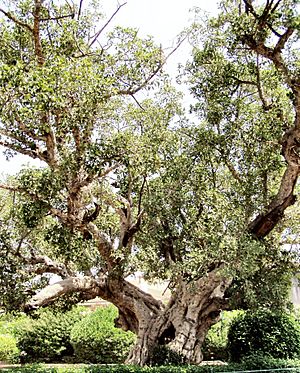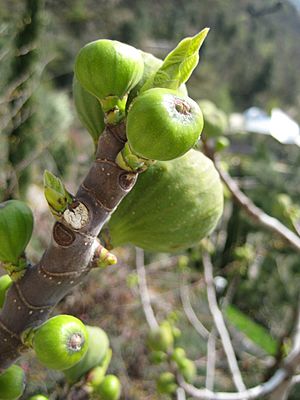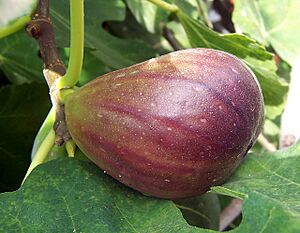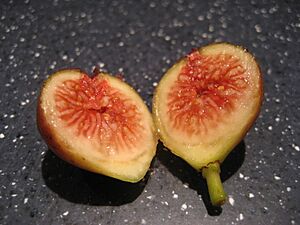Fig facts for kids
Quick facts for kids Fig trees |
|
|---|---|
 |
|
| Sycamore fig, Ficus sycomorus | |
| Scientific classification |
|
| Kingdom: | Plantae |
| Clade: | Tracheophytes |
| Clade: | Angiosperms |
| Clade: | Eudicots |
| Clade: | Rosids |
| Order: | Rosales |
| Family: | Moraceae |
| Tribe: | Ficeae Dumort. |
| Genus: | Ficus L. |
| Species | |
|
About 800, see text |
|
A fig (from the genus Ficus) is a soft, sweet fruit. It has very thin skin and many tiny seeds inside. There are more than 850 different kinds of Ficus, which is the fig tree.
People can eat figs when they are fresh and ripe, or when they are dried. Figs grow best in warm climates. Sometimes, figs are used to make jam. Figs are also a popular snack.
Figs are pollinated by tiny fig wasps.
Contents
What are Figs?
Many types of figs are grown for their fruit. However, the common fig is the most popular kind for people to eat.
A fig "fruit" is actually a special kind of multiple fruit. This means that its flowers and seeds grow together to form one single mass. Depending on the type, each fig can have hundreds or even thousands of seeds inside.
The fig fruit is unique because its many small flowers are hidden inside. You cannot see the actual flowers unless you cut the fig open. This is why it is sometimes called a fruit without a visible flower.
What's Inside a Fig?
Fig fruits are important as both food and traditional medicine. They contain things that can help with digestion, like laxative substances. They also have natural colors called pigments, and natural sugars. Figs are also a source of vitamins A and C, acids, and enzymes.
However, some people can have allergies to figs, especially their skin. The sap from the fig tree can also irritate your eyes.
Growing Figs on Farms
Some common fig farms grow "virgin fruit." This means they do not need pollination at all. These farms can produce seedless figs that are good to eat, even without fig wasps.
How Figs are Pollinated
Figs are pollinated by very small wasps. The fig fruit, called a syconium, usually has a round shape with a small opening at the end. This opening is called the ostiole. The tiny wasps use this opening to crawl inside the fig. They are looking for a good place to lay their eggs.
Without these wasps, fig trees cannot make seeds to grow new trees. In return, the fig flowers give the next generation of wasps a safe home and food. This special relationship has developed over a very long time, which is called co-evolution.
The common fig (Ficus carica) is a special type of plant. Its fruits are either "inedible figs" or "caprifigs." These caprifigs were traditionally fed to goats. The other type of fig tree produces the "edible figs" that we eat.
Fig wasps grow inside caprifigs. However, they cannot lay their eggs in the edible figs. This is because the female flowers inside edible figs are too long for the wasp to reach. Even so, the wasp still pollinates the edible fig with pollen from the caprifig where it grew up. When the wasp dies inside the fig, special enzymes break it down. This means you do not eat the wasp because it has dissolved. The wasps do not carry diseases that are harmful to humans.
Figs and Humans
The edible fig is one of the very first plants that humans ever grew for food.
A Special Partnership
Usually, there is only one type of wasp that can pollinate each different kind of fig. For example, in Hawaii, about 60 types of figs have been brought there. But only four of the wasps that pollinate them were also brought. This means only four kinds of figs can produce seeds there. This shows a helpful relationship where both the fig plant and the fig wasp benefit each other.
This close relationship between fig types and their pollinators is a clear example of coevolution. Recent studies show that figs and wasps have evolved together in a very close way.
Images for kids
-
"Schiocca": Calabrian dried figs
-
Still life Mesa ("Table") with dried figs and other fruits in a bowl by Clara Peeters, 1611
See also
 In Spanish: Higuera para niños
In Spanish: Higuera para niños












